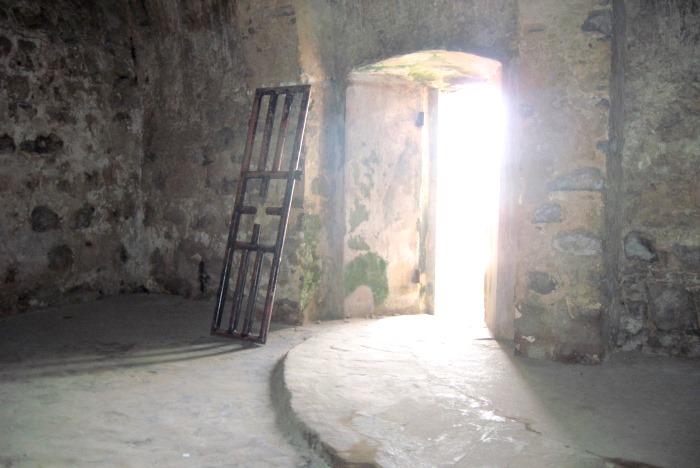A Quick Look: The Atlantic Slave Trade Mosaic

Once captured Africans went through "The Door of No Return" in Ghana's Elmina Castle, they would be shipped to the New World as slaves, never to see the shores of Africa again. Photo courtesy of Lynn Johnson.
During the West Africa leg of a recent Mosaic, students feel history's presence
by Tony Moore
Students taking part in the Atlantic Slave Trade Mosaic last fall explored both ends of the busiest Africa–North America route of the slave-trade era, visiting historical sites in West Africa’s Ghana and Charleston, S.C.
Mosaics are are intensive, interdisciplinary research programs designed around ethnographic fieldwork and immersion in domestic and global communities. And the Ghana leg of this Mosaic, led by Assistant Professor of Africana Studies Lynn Johnson, left the traditional classroom 5,000 miles behind, and the experience transcended anything the group might have expected. Below are some of the things they took away from their time on Africa's Atlantic coast.
Hannah Glick ’15: When we were in Elmina Castle, the entire tour group was locked into one room, and we were so close together, and we could hear the waves and look through a tiny peephole of a window, and it was awful. That was the last sound before [the captives] went to the New World, and they had that sound with them the entire voyage. That sound, of the ocean, was a trigger for a lot of people [in the tour].
Dominique Brown ’15: Where we stayed was right on the coast of the Atlantic Ocean. For me, that was very unsettling. The first few nights I really couldn’t sleep. I was constantly tossing and turning. The fact that it was the Atlantic Ocean, that that body of water had such a specific purpose in the slave trade … it just was very uneasy to even think how many bodies were lost in that ocean. Hearing the ocean from the slave ships and not being able to see it, being in darkness for months—it was very hard to wrap my mind around.
Lynn Johnson: The first time I went [to Ghana], I was in awe. How did they really survive in these spaces, in this dank dungeon? And then you really start to understand that you need to learn more about it, not just about victimization but survival. I had to look at it personally as, “I am a descendant of these powerful people.”
Frank Williams III ’15: Some parts of me feel more connected to Africa, and other parts I would characterize as a part of my American identity. This Mosaic really helped me come to terms with that. Having been to Africa and having experienced Ghanaian culture along with having lived in America for 20 years, I am proud to say that I am uniquely (and unapologetically) African American. This experience really challenged my belief that I had no real place to belong.
Look for the full story, including the Mosaic experience in Charleston, in the spring 2014 issue of Dickinson Magazine.

Students enter Cape Coast Castle, where slaves were housed before their journey across the Atlantic. Photo courtesy of Maretta Sonn '17.
Read more
American and Global Mosaics overview
Explore previous Mosaics
Dickinson's Africana studies department
Read an article from the Ghana News Agency about how the students helped paint a maternity ward while in Cape Coast, Ghana
Published February 19, 2014